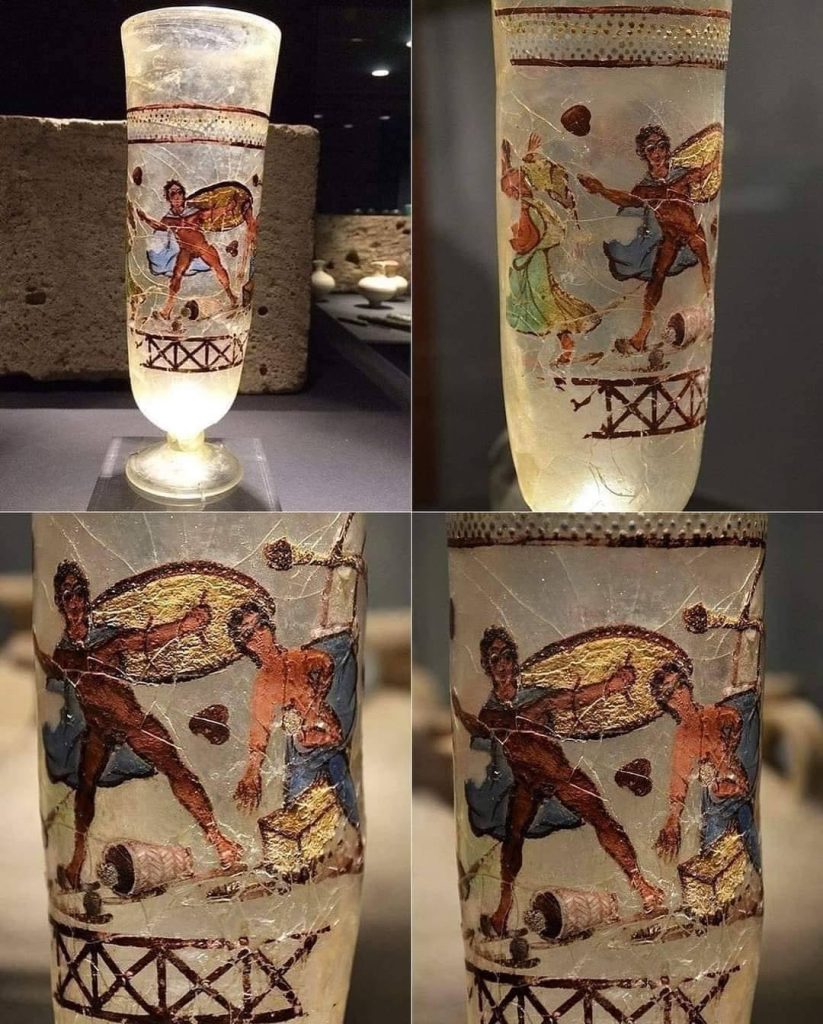In the field of archaeology, few discoveries have the power to bridge the ancient and modern worlds in a way that truly captivates both scholars and the public. Yet in 1991, in the historic city of Cologne, Germany, archaeologists uncovered an extraordinary artifact that has continued to inspire fascination and scholarly inquiry. This artifact, a Roman painted goblet dating back to the 3rd century AD, stands as a vivid testament to the artistic brilliance and cultural sophistication of ancient Rome. Remarkably well-preserved despite the passage of nearly 1,700 years, this goblet showcases not only the technical mastery of Roman artisans but also offers rare insight into the mythological themes that shaped Roman society.

The goblet’s most striking feature is its detailed depiction of a scene from Greek mythology—the revealing of Achilles on the island of Skyros. This myth, widely known in antiquity, tells of how Achilles’ mother, Thetis, fearing for her son’s life, disguised him as a girl to prevent him from being drafted into the Trojan War. However, Odysseus, known for his cunning, uncovered Achilles’ identity by presenting gifts suited for a warrior among those for women, prompting Achilles to reveal his true nature. The choice to feature this particular scene reflects not only the Roman admiration for Greek mythology but also their fascination with themes of fate, identity, and heroism. These were values deeply embedded in Roman culture, often portrayed in literature, sculpture, and as seen here, glassware.
From a technical perspective, the goblet exemplifies the apex of Roman glassmaking. It features thin-walled construction—a technique that required tremendous skill and precision—and retains its original enamel paint with an intensity of color that defies its age. The reds, blues, and golds remain remarkably vivid, a fact that continues to astonish conservationists and scientists alike. This level of preservation is rare for glass artifacts, which are typically vulnerable to degradation over time. The goblet’s survival in such condition has allowed researchers a unique opportunity to study Roman craftsmanship with unparalleled clarity.
Delving deeper into the goblet’s structure, researchers have uncovered valuable information about the materials and methods used by Roman artisans. Analysis of the enamel revealed the use of natural mineral pigments combined with sophisticated binding agents, likely derived from organic materials. The glass itself was produced using advanced kiln techniques, with temperatures precisely controlled to achieve clarity and strength without compromising the thinness of the walls. This level of control indicates a highly developed understanding of chemistry and engineering—fields that modern historians are only beginning to fully appreciate in the context of the Roman Empire.
Beyond its artistic and technical merits, the goblet serves as a cultural artifact that underscores the reach and influence of Roman civilization. Cologne, known as Colonia Claudia Ara Agrippinensium during the Roman era, was a prominent outpost of the empire. The presence of such an exquisite piece in this region highlights the widespread distribution of luxury goods and the connectivity of Roman trade routes. It also reflects the degree to which Roman elites in the provinces adopted and celebrated the cultural norms of the capital, including the appreciation of fine art and mythological narratives.
The discovery of this goblet has had a profound impact on modern scholarship. By enabling detailed analysis of ancient manufacturing techniques, it has contributed to a more nuanced understanding of Roman technological capabilities. Furthermore, it has encouraged a reevaluation of the cultural interactions between Rome and the Greek world, emphasizing the extent to which Roman identity was shaped by Hellenic influences. The goblet thus acts as a bridge not only between ancient and modern times but also between the diverse regions and cultures of the ancient Mediterranean.
Preservation of the goblet has become a top priority for curators and conservators. Given the fragility of both the glass and the painted surface, specialized techniques have been employed to ensure its longevity. These include maintaining a controlled climate, limiting exposure to light, and using non-invasive methods for any necessary cleaning or restoration. Such efforts are vital in safeguarding this irreplaceable artifact for future generations to study and admire.
Ultimately, the Cologne Goblet is far more than an archaeological curiosity; it is a window into a world that, while distant in time, continues to resonate with our own. Its intricate artwork, its vivid storytelling, and its flawless craftsmanship speak to the enduring human drive to create, to commemorate, and to connect across time and space. As we marvel at this masterpiece, we are reminded of the boundless creativity that has defined our species for millennia. The goblet’s survival offers not only a rare glimpse into the past but also a powerful symbol of continuity, a tangible link that unites us with the artisans and storytellers of ancient Rome. In its preservation, we find inspiration—a call to cherish and study the legacies of those who came before us, and to recognize in their achievements the roots of our own civilization.





